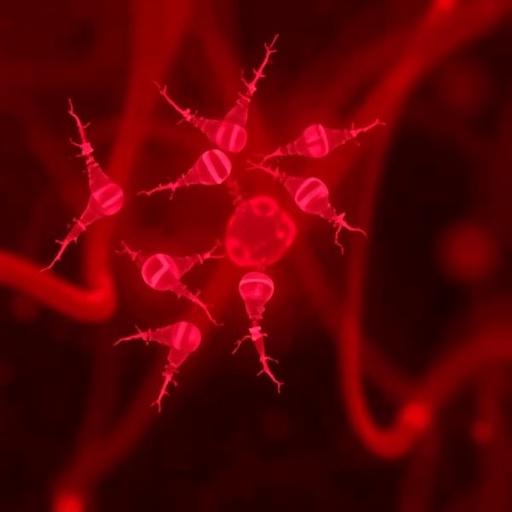
In a groundbreaking study published in BMC Cancer, researchers have unveiled a novel approach to cervical cancer screening by enabling the in situ co-detection of aneuploid tumor cells (TCs) and tumor endothelial cells (TECs) within cytological specimens. This innovative method integrates immunofluorescence staining with fluorescence in situ hybridization (iFISH), offering unprecedented insights into the phenotypic and karyotypic properties of cells implicated in cervical lesion progression.
Cervical cancer screening has long relied on cytological assessment and high-risk human papillomavirus (HPV) detection to identify precancerous changes and early-stage malignancies. However, current techniques often struggle to differentiate between subpopulations of tumor and endothelial cells, limiting their diagnostic precision. The new study addresses this gap by characterizing aneuploid CD31-negative tumor cells and CD31-positive tumor endothelial cells, correlating their abundance and characteristics with lesion severity and HPV status.
The study cohort consisted of 196 patients presenting with abnormal cervical screening results, encompassing a broad spectrum of lesion stages. By employing immunofluorescence staining targeting p16 and Ki67 markers alongside FISH analysis of chromosomal abnormalities, the team meticulously quantified aneuploid cell subsets. This approach allowed the direct visualization and differentiation of tumor cells lacking the endothelial marker CD31 from tumor-associated endothelial cells expressing CD31, both exhibiting distinct chromosomal aneuploidies.
Results demonstrated a marked increase in the number of total aneuploid CD31-negative tumor cells as cervical lesions progressed in severity, underscoring a strong association between the degree of aneuploidy in tumor cells and lesion grade. Specifically, the subpopulations of tumor cells that were positive for p16 and/or Ki67 exhibited a pronounced elevation correlating with more advanced stages. In stark contrast, the frequency of aneuploid CD31-positive tumor endothelial cells did not show a similar trend, suggesting divergent biological roles and diagnostic relevance between these cellular compartments.
Interestingly, the study revealed distinct patterns of aneuploid tumor cell proliferation related to different high-risk HPV types. HPV16 and HPV18 infections predominantly contributed to increased aneuploid tumor cells in low-grade squamous intraepithelial lesions (LSIL), whereas non-HPV16/18 high-risk HPV types were mainly associated with elevated aneuploid tumor cells in high-grade squamous intraepithelial lesions (HSIL). This finding highlights the nuanced pathophysiological impact of specific HPV genotypes on cellular dynamics within cervical lesions.
From a diagnostic standpoint, the evaluation of aneuploid tumor cell subtypes through receiver operating characteristic (ROC) curve analysis underscored their potential clinical utility in identifying HSIL and more severe lesions (HSIL⁺). The study found the area under the curve (AUC) for tetraploid tumor cells was the highest among the karyotypic subtypes, reaching 0.739, followed closely by multiploid (≥ pentaploid) and triploid tumor cells. When combined, tetraploid and higher ploidy tumor cell counts yielded an AUC of 0.745, reflecting strong diagnostic performance with notable specificity.
Such high specificity is vitally important in cervical cancer screening to reduce false-positive rates and avoid unnecessary invasive procedures. The ability to selectively detect and quantify aneuploid tumor cells that accurately correlate with clinically significant lesion grades may revolutionize existing screening algorithms by enhancing early detection and risk stratification. Furthermore, this technique could serve as a valuable adjunct to HPV typing and cytological evaluation in guiding clinical management decisions.
The integration of immunofluorescence and FISH within a single tumor tissue biopsy platform exemplifies a state-of-the-art methodological advance facilitating in situ phenotypic and karyotypic characterization. This methodological innovation allows for spatial resolution of cellular phenotypes alongside chromosomal status, overcoming limitations of traditional cytology and molecular techniques that often analyze mixed cell populations without preserving tissue context.
Significantly, the study draws attention to the underexplored role of tumor endothelial cells in cervical neoplasia. Despite aneuploidy being a hallmark of malignant transformation, the lack of a consistent increase in aneuploid CD31-positive TECs across lesion grades suggests these cells may not serve as reliable diagnostic markers. Still, their presence and unique biological contributions warrant further investigation, particularly in relation to angiogenesis and tumor microenvironment interactions.
Moreover, the research approach offers the potential to extend beyond cervical cancer to other malignancies where tumor and endothelial cell karyotypic heterogeneity impacts disease progression and treatment response. Adapting this iFISH-based method could facilitate comprehensive cellular profiling and enhance precision oncology strategies by targeting distinct tumor subpopulations.
Notwithstanding these promising findings, the authors emphasize the need for larger-scale studies to validate the clinical utility of CD31-negative aneuploid tumor cell detection. Longitudinal studies investigating the prognostic implications and response to therapy are crucial to translating this research into clinical practice. Furthermore, automated image analysis and quantification pipelines may streamline the methodology, rendering it adaptable for routine diagnostic laboratories.
In conclusion, this pioneering study represents a significant leap forward in cervical cancer diagnostics by offering a robust and specific modality to detect and characterize aneuploid tumor cells within cytological specimens. The integration of phenotypic and karyotypic co-detection holds promise to refine screening accuracy, tailor patient management, and ultimately improve outcomes for women at risk of cervical cancer. As HPV-driven cervical lesion biology continues to be elucidated, such innovative molecular pathology tools will become indispensable components of personalized gynecologic oncology.
This research not only enriches our understanding of cervical lesion pathogenesis but also sets the stage for biomarker development that transcends traditional histopathological assessments. The elucidation of distinct roles for tumor and endothelial cells marked by differential aneuploidy enhances the granularity of diagnostic precision, facilitating new avenues for early detection and therapeutic targeting in oncology.
The findings implore the scientific community to embrace multidimensional cellular analysis approaches that integrate phenotypic markers with genetic aberrations in situ. This convergence of immunofluorescence and cytogenetic technologies paves the way for transformative improvements in cancer diagnostics, reaffirming the pivotal role of molecular cytology in the era of precision medicine.
As the burden of cervical cancer persists globally, especially in low-resource settings, innovations like this hold particular significance. They promise scalable solutions that combine morphological insights with molecular specificity, empowering clinicians to navigate complex screening landscapes effectively and reducing morbidity through early intervention.
The study by Wang and colleagues marks a vital step in realizing this vision, demonstrating that sophisticated cellular co-detection methods can provide clinically actionable data from routine cytological specimens. This approach heralds a future wherein the integration of phenotypic and karyotypic information becomes standard practice, elevating the quality and impact of cancer screening programs worldwide.
Subject of Research: In situ co-detection and analysis of aneuploid tumor cells (TCs) and tumor endothelial cells (TECs) in cervical cytological specimens, focusing on the diagnostic implications for cervical lesion progression related to high-risk HPV infection.
Article Title: In situ phenotypic and karyotypic co-detection of aneuploid TCs and TECs in cytological specimens with abnormal cervical screening results
Article References:
Wang, Y., Lin, A.Y., Wang, D.D. et al. In situ phenotypic and karyotypic co-detection of aneuploid TCs and TECs in cytological specimens with abnormal cervical screening results. BMC Cancer 25, 945 (2025). https://doi.org/10.1186/s12885-025-14346-y
Image Credits: Scienmag.com
DOI: https://doi.org/10.1186/s12885-025-14346-y
Tags: abnormal cervical screening resultsaneuploid tumor cell detectioncervical cancer screening techniqueschromosomal abnormalities in cancercytological specimen analysisdiagnostic precision in cervical lesionsfluorescence in situ hybridization applicationsHPV status correlationimmunofluorescence staining methodsimmunohistochemistry in cancer researchphenotypic properties of tumor cellstumor endothelial cell characterization



